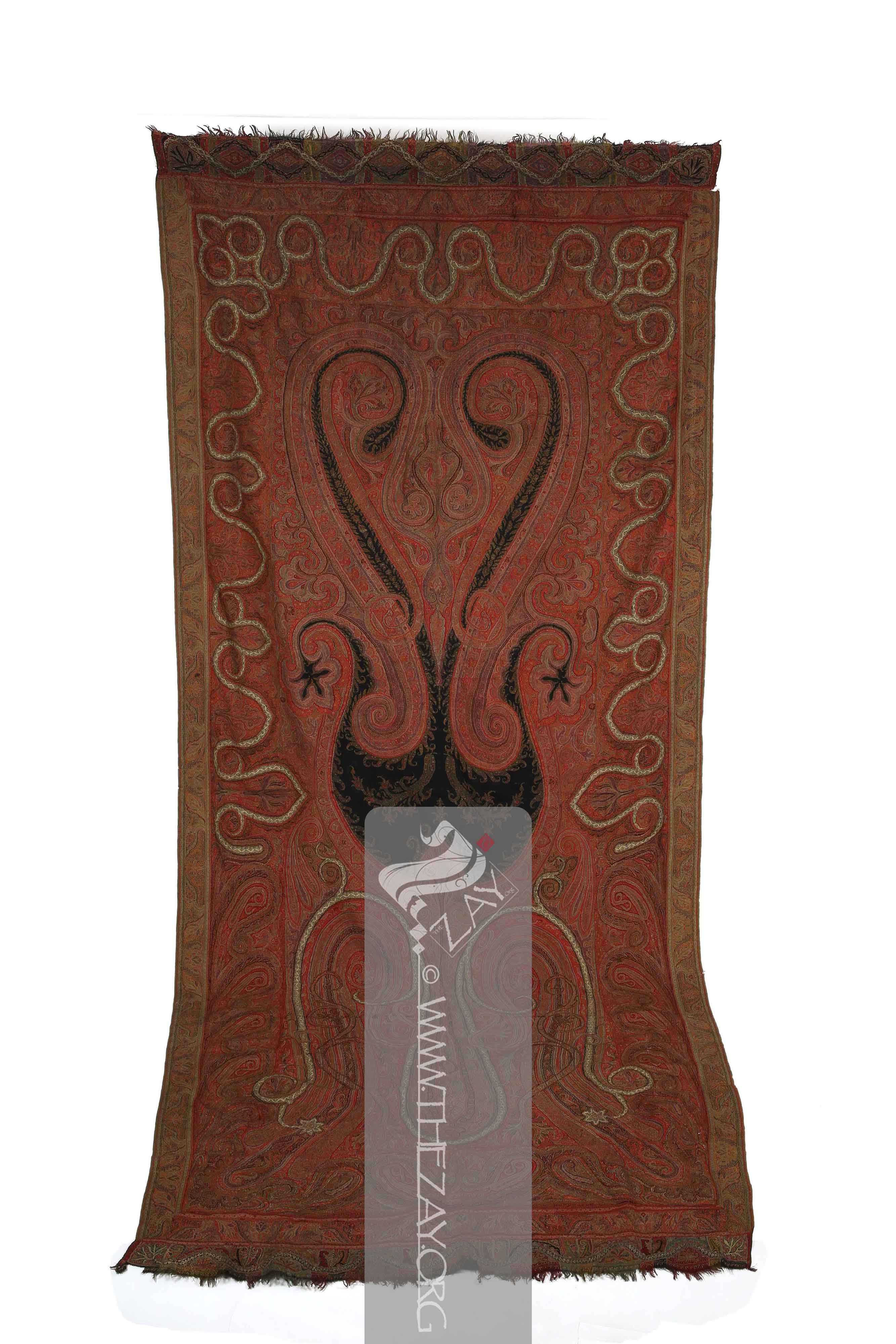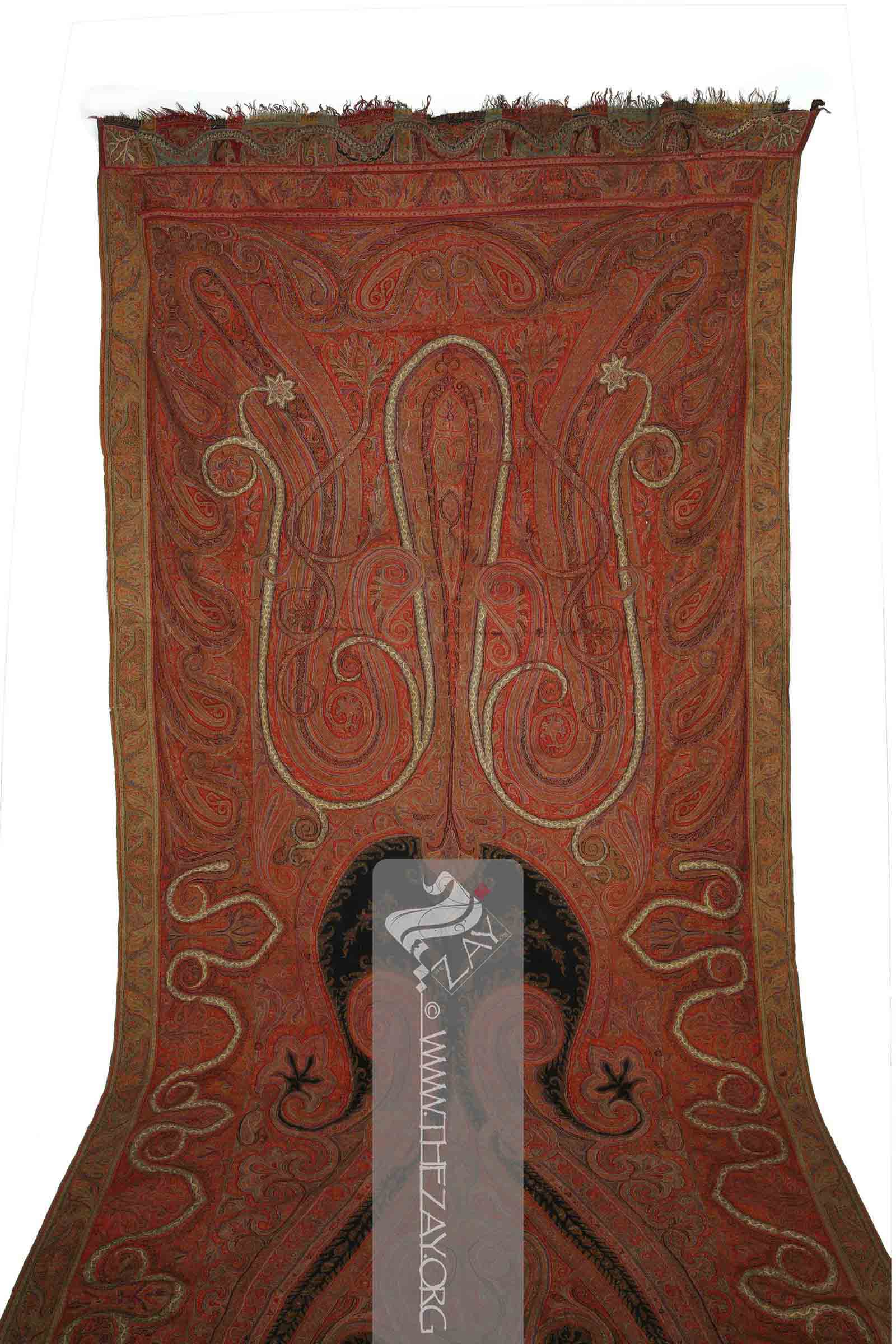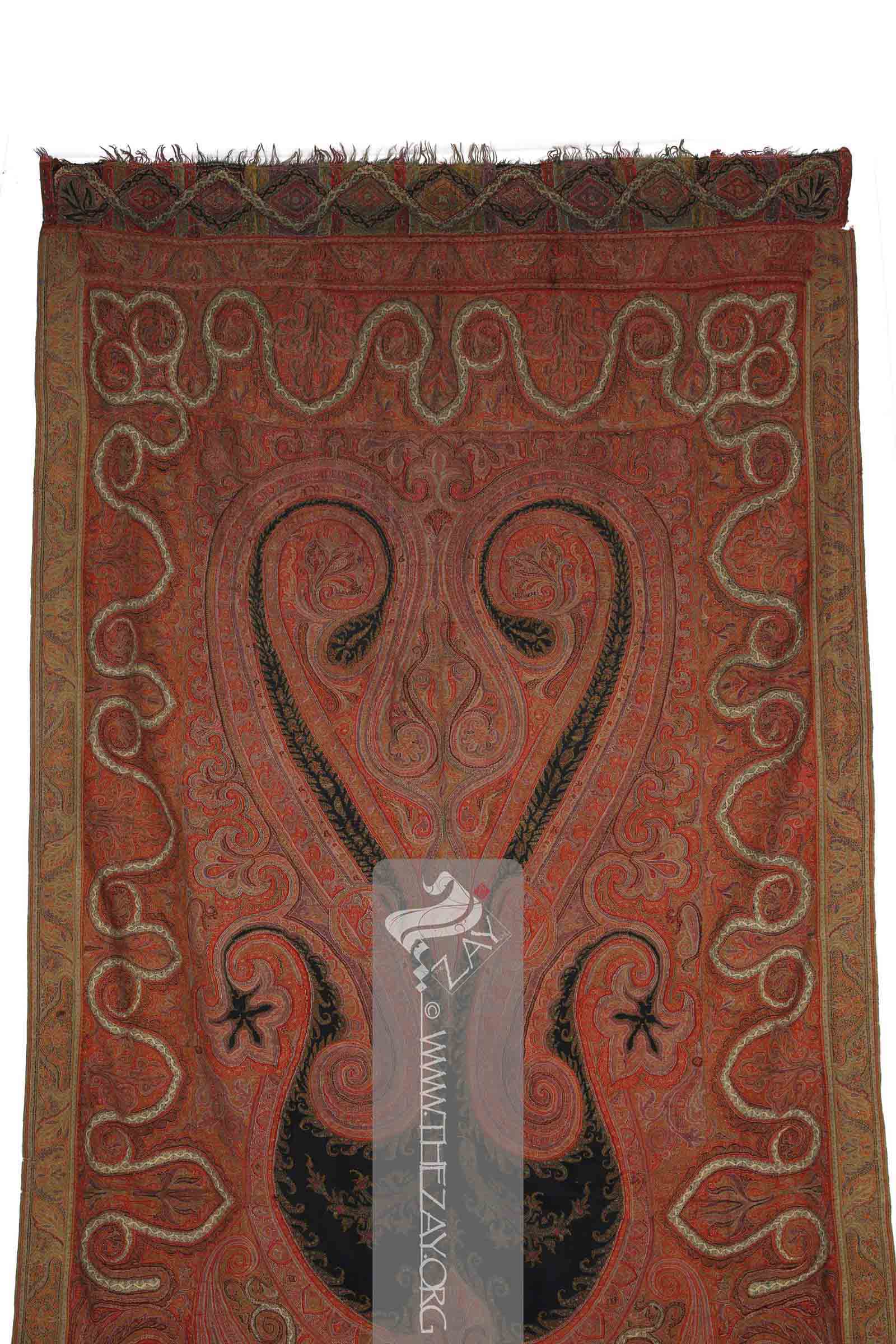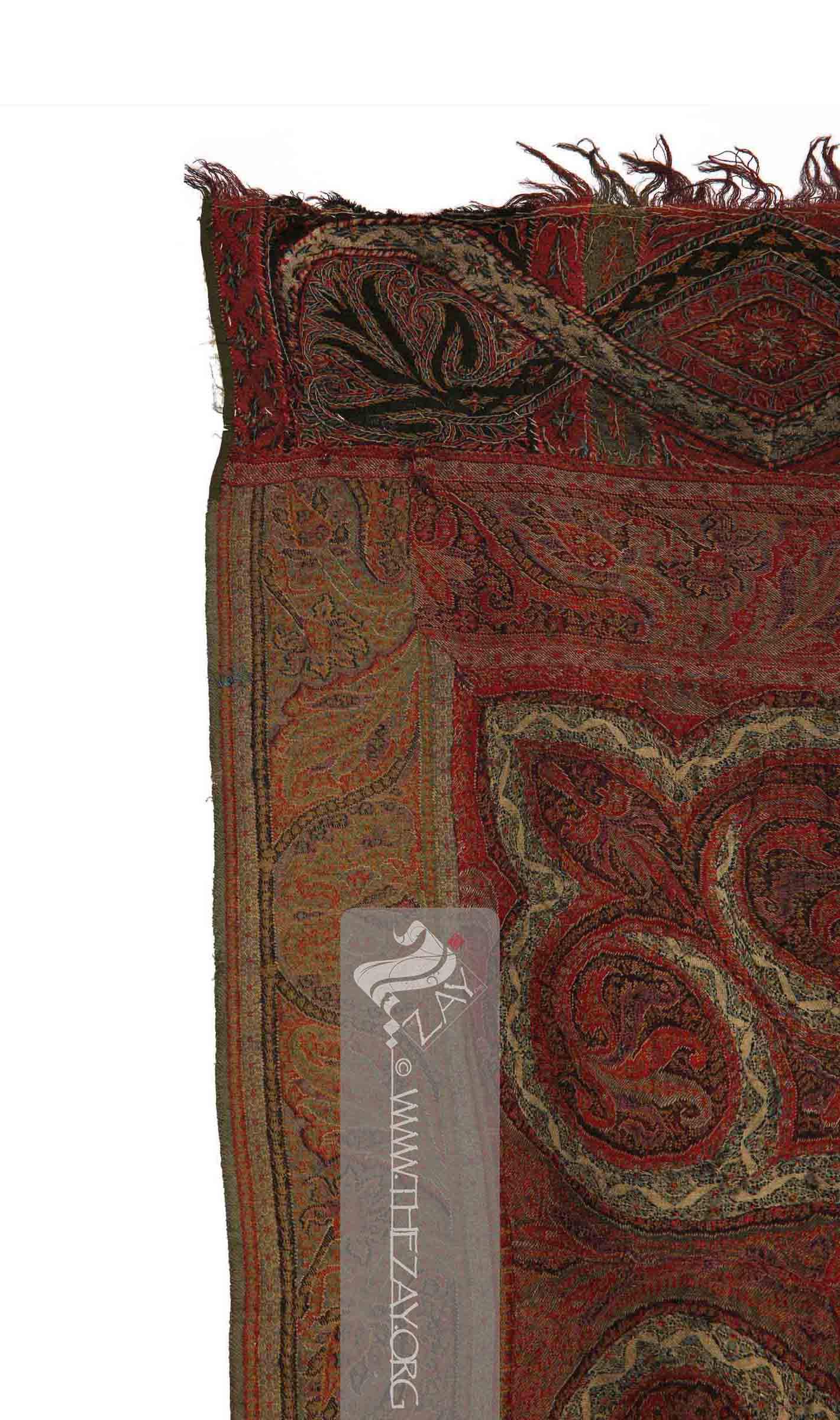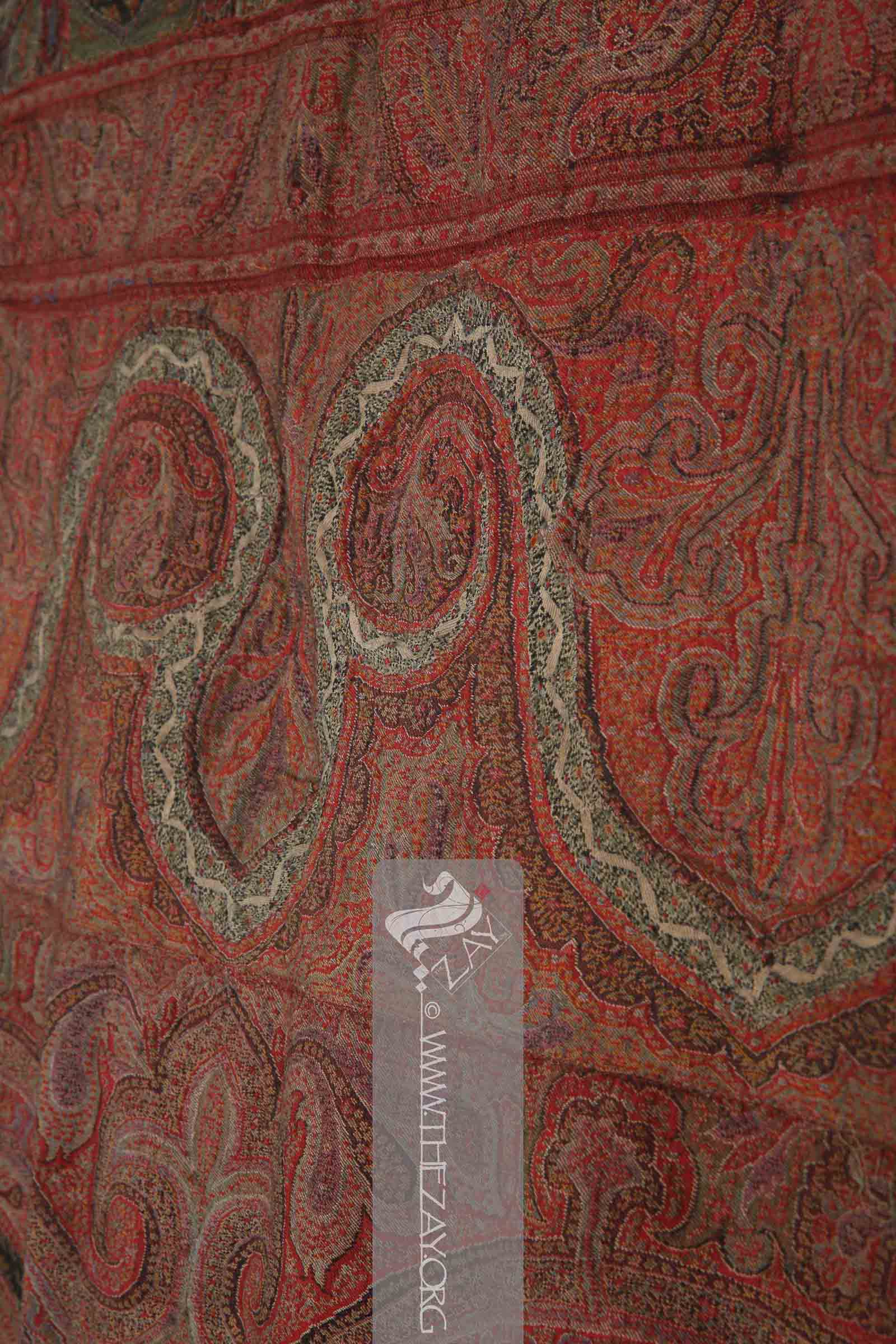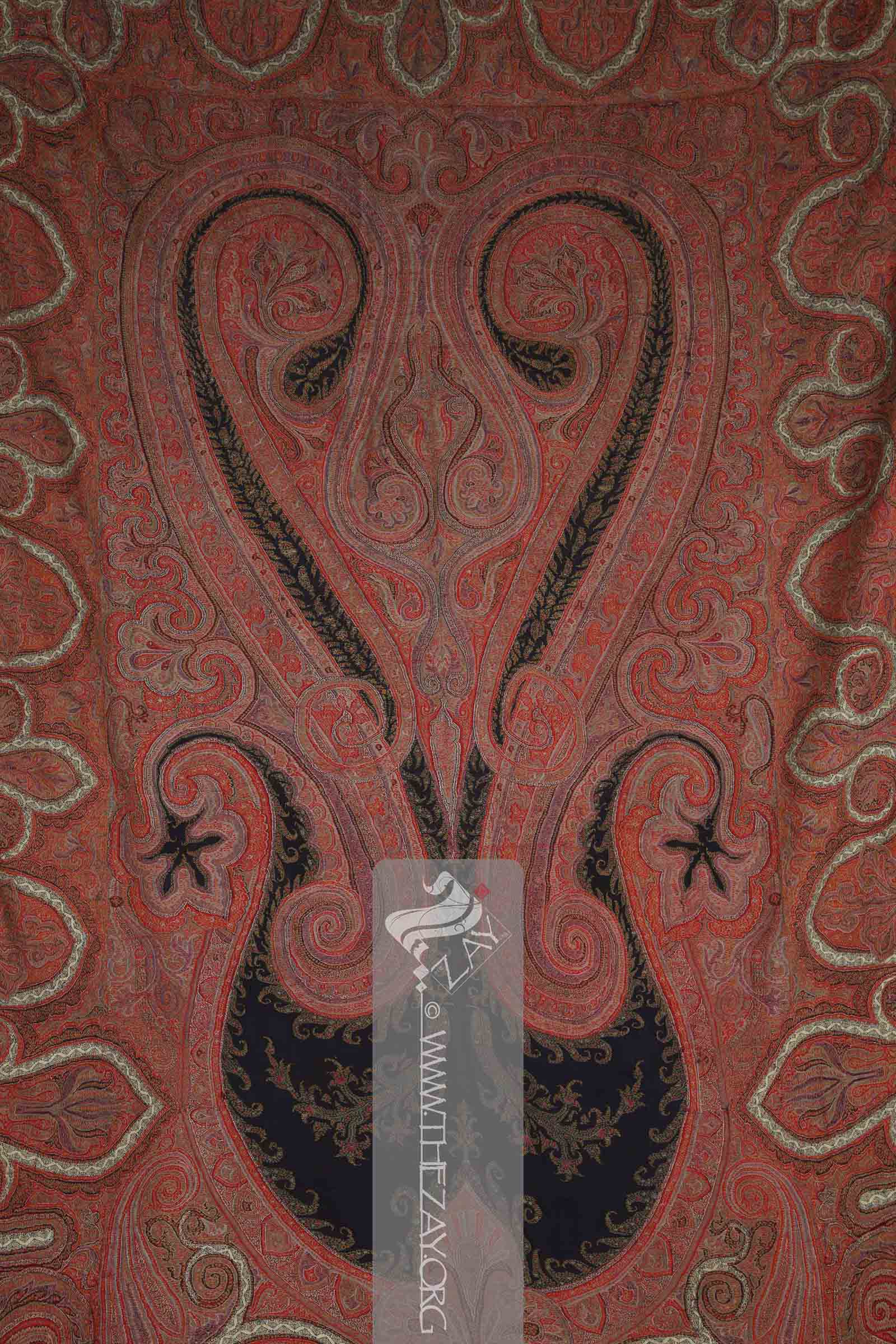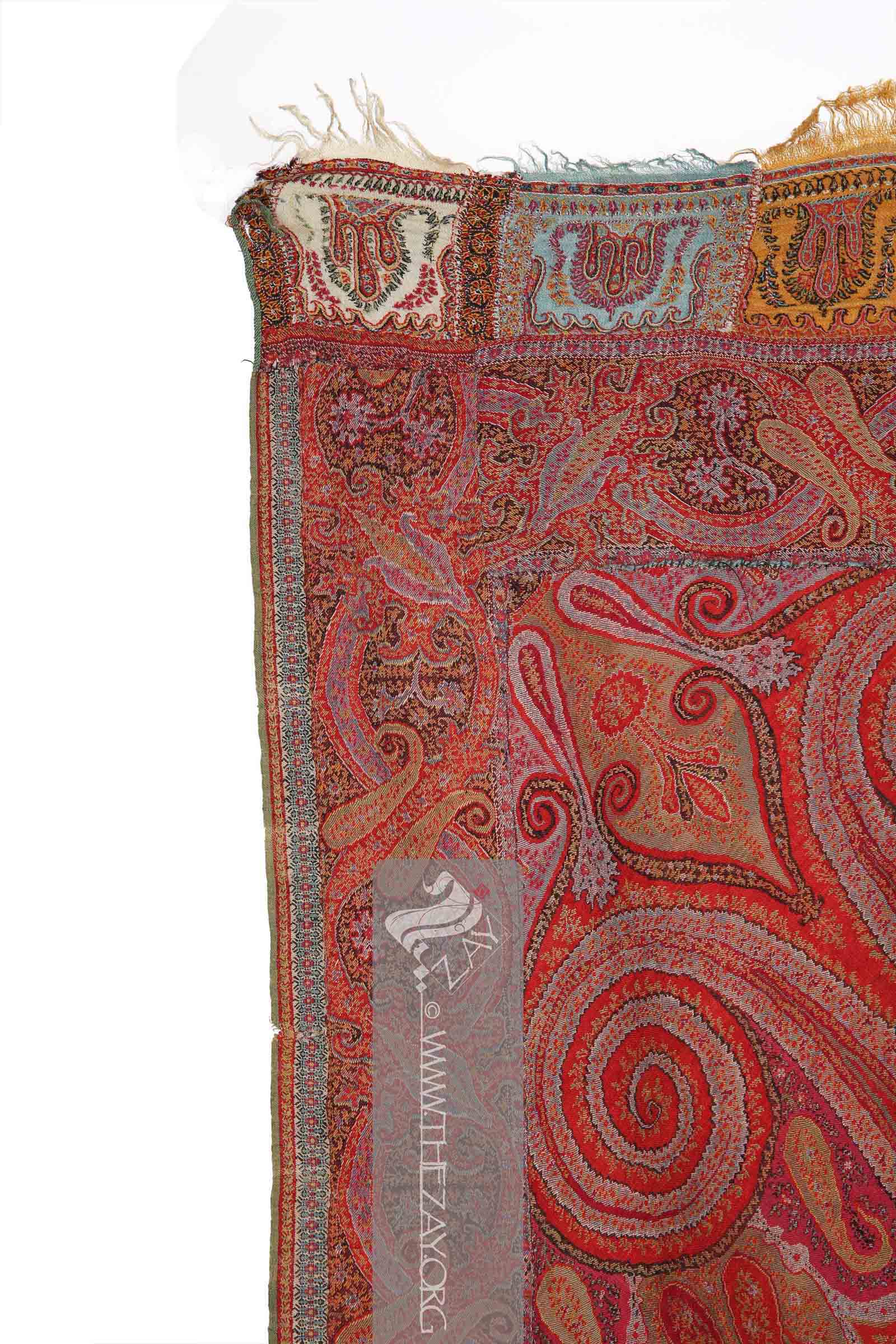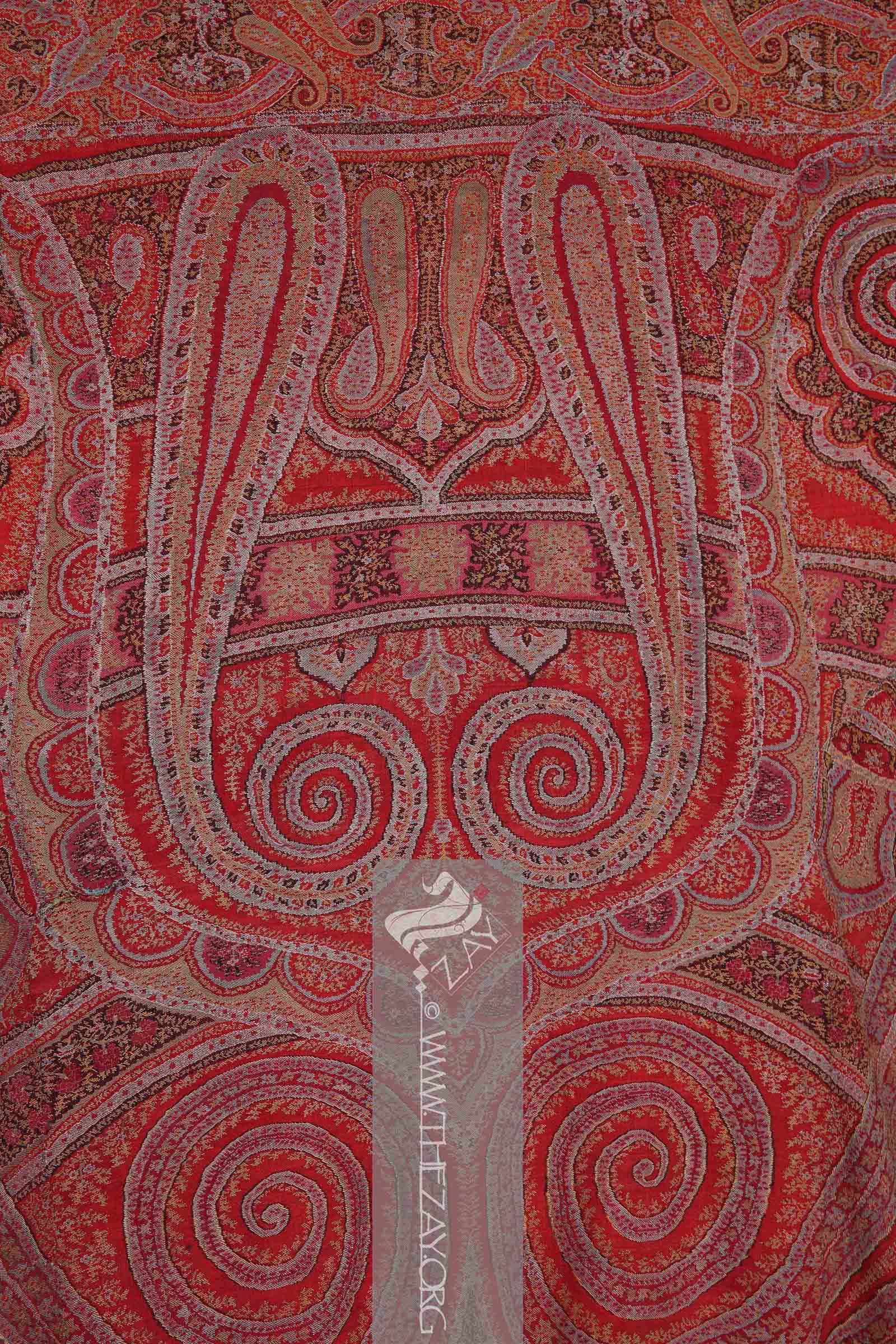Object History This Kashmiri
Kashmiri: (Hindustani: Kashmir – a region in South Asia), a term used to denote or identify anything related to the region – its people, their language, culture, art and craft, society etc. twill
Twill: (English), one of the three primary textile weaves is defined by its prominent diagonal rib pattern. The fabrics woven in this method typically exhibit a pronounced, often darker front side, while the back is lighter.
tapestry
Tapestry: wall hanging or other large piece of fabric that is woven in coloured weft threads or embroidered with a decorative design. Typically made of wool, but they can also be made of other materials such as silk, linen, or cotton. Often used to decorate homes, churches, and other buildings. (Kani
Kānī: (Kashmiri
Kashmiri: (Hindustani: Kashmir – a region in South Asia), a term used to denote or identify anything related to the region – its people, their language, culture, art and craft, society etc. : Small sticks, also a name of a village in Kashmir), a type of weave that originated in this village where wooden bobbins or sticks are used as spools on the loom to create intricate patterns instead of a shuttle.
) brocaded (jamawar
Jāmāwar: (Hindi, Jama
Jāma: (Persian, Synonym: Juma
Jūma: (Persian, Synonym: Jama), a mantle to cover the torso. Amongst the women in south of Iran specially from Hormozgan it is a loose shift tunic dress, however the connotation changes and is used to refer to a shirt dress by the women further north.), a mantle to cover the torso. Amongst the women in south of Iran specially from Hormozgan it is a loose shift tunic dress, however the connotation changes and is used to refer to a shirt dress by the women further north.: robe and war/var: chest or body), a portmanteau word meaning anything that covers the body. Originally brocade
Brocade: (Italian: brocco – twisted thread), is a richly decorative fabric woven with an intricate raised pattern. Its origins can be traced back to ancient China, where it was made for the imperial court. It later spread to Europe during the Renaissance and became popular in couture and decorative arts. silk of intricate and overlapping patterns first introduced by the traders from Samarkand and Bukhara to the subcontinent and was adopted in wool specifically in pashmina
Pāshmīna: (Persian: pašm or pashm – wool), pashmina scarves are eponymous woolen shawls from the Kashmir region with a history dating back to more than 500 years. It is the finest variant of spun cashmere
Cashmere: (Anglisized from Hindustani: Kashmir – A region or province in the Indian subcontinent), a fine soft natural wool, from the hair of goats native to the Kashmir, Ladakh and neighbouring regions of the Indian subcontinent. Often confused with Pashmina, it should be noted that all cashmeres are not pashmina. wool extracted from the downy undercoat of the Changthangi goats found in the Ladakh province. . ) scarf
Scarf: (English), usually a rectangular piece of cloth loosely worn over the shoulders, upper body and arms, and sometimes also over the head./wrap (shawl
Shawl: (Persian: shāl from Hindi: duśālā – Shoulder Mantle), a shawl is a South Asian version of a scarf
Scarf: (English), usually a rectangular piece of cloth loosely worn over the shoulders, upper body and arms, and sometimes also over the head. worn or wrapped loosely over the shoulders and is usually made of wool. ) dating back to the mid-19th century was originally a part of the Dr Joan Coleman Collection. It was first purchased on July 28, 1977, at an auction in Christie’s, London, and later The Zay
Zay: (Arabic: costume, Pl. azyaā’), a set of clothes in a style typical of a particular country or historical period. Initiative managed to acquire it from Kerry Taylor Auctions in 2020. Dr Joan Coleman began collecting shawls in 1976 and developed her lifelong passion for collecting. She was a regular at the London salesrooms of Christie’s, Sotheby’s, and Phillips – three of the most outstanding auction houses of the period in the world – getting to know the dealers and learning in the process. She acquired vast knowledge and dedicated hours carefully cataloguing her ever-growing collection. She intended to loan her collection to different museums and institutions for the benefit of learning and education. Her collection is one of the largest and the finest private shawl
Shawl: (Persian: shāl from Hindi: duśālā – Shoulder Mantle), a shawl is a South Asian version of a scarf
Scarf: (English), usually a rectangular piece of cloth loosely worn over the shoulders, upper body and arms, and sometimes also over the head. worn or wrapped loosely over the shoulders and is usually made of wool. collections to have ever graced the world with shawls ranging from Kashmir, Paisley
Paisley: (Scottish Gaelic, Pàislig: a town in Scotland), often called buta
Būta: (Anglicized Persian: boteh – Pinecone shaped motif), known as paisley in English it is the almond or pinecone-shaped motif, especially in textiles. It is believed to have originated from the Cyprus tree a Zoroastrian symbol for life and eternity. In the current Indian context, however, it simply means motif., boteh, amli, or kalgi in the subcontinent and kazuwah in Arabic, is a Persian tear drop motif with a curved end specially in textiles. Its popularity and subsequent local production in 18th century at Paisley are responsible for its nomenclature., Edinburgh, Norwich, France, and Iran. Object Features This rectangular
shawl
Shawl: (Persian: shāl from Hindi: duśālā – Shoulder Mantle), a shawl is a South Asian version of a scarf
Scarf: (English), usually a rectangular piece of cloth loosely worn over the shoulders, upper body and arms, and sometimes also over the head. worn or wrapped loosely over the shoulders and is usually made of wool. is made of several patches of polychrome woven fabric sewn together on a red (
madder
Mādir: (Latin: Rubia tinctorum – Eurasian herb), rose madder, common madder or dyer's madder is a vegetable dye made from the roots of a perennial plant belonging to the bedstraw and coffee family. It has been used extensively as a vegetable red dye across the globe from India to England. ) base. Woven by hand on several looms embellished with hand embroidery and hand-stitched this fabric is filled with arabesque,
paisley
Paisley: (Scottish Gaelic, Pàislig: a town in Scotland), often called buta
Būta: (Anglicized Persian: boteh – Pinecone shaped motif), known as paisley in English it is the almond or pinecone-shaped motif, especially in textiles. It is believed to have originated from the Cyprus tree a Zoroastrian symbol for life and eternity. In the current Indian context, however, it simply means motif., boteh, amli, or kalgi in the subcontinent and kazuwah in Arabic, is a Persian tear drop motif with a curved end specially in textiles. Its popularity and subsequent local production in 18th century at Paisley are responsible for its nomenclature. and floral motifs. The central panel constitutes of two mirrored arabesque patterns, one in black and the other in ivory with the floral patterns sprouting inside in contrasting colours. Both patterns are flanked by more subtle
madder
Mādir: (Latin: Rubia tinctorum – Eurasian herb), rose madder, common madder or dyer's madder is a vegetable dye made from the roots of a perennial plant belonging to the bedstraw and coffee family. It has been used extensively as a vegetable red dye across the globe from India to England. based
paisley
Paisley: (Scottish Gaelic, Pàislig: a town in Scotland), often called buta
Būta: (Anglicized Persian: boteh – Pinecone shaped motif), known as paisley in English it is the almond or pinecone-shaped motif, especially in textiles. It is believed to have originated from the Cyprus tree a Zoroastrian symbol for life and eternity. In the current Indian context, however, it simply means motif., boteh, amli, or kalgi in the subcontinent and kazuwah in Arabic, is a Persian tear drop motif with a curved end specially in textiles. Its popularity and subsequent local production in 18th century at Paisley are responsible for its nomenclature. patterns that sprout on the outer edges. The two
cashmere
Cashmere: (Anglisized from Hindustani: Kashmir – A region or province in the Indian subcontinent), a fine soft natural wool, from the hair of goats native to the Kashmir, Ladakh and neighbouring regions of the Indian subcontinent. Often confused with Pashmina, it should be noted that all cashmeres are not pashmina. (
pashmina
Pāshmīna: (Persian: pašm or pashm – wool), pashmina scarves are eponymous woolen shawls from the Kashmir region with a history dating back to more than 500 years. It is the finest variant of spun cashmere
Cashmere: (Anglisized from Hindustani: Kashmir – A region or province in the Indian subcontinent), a fine soft natural wool, from the hair of goats native to the Kashmir, Ladakh and neighbouring regions of the Indian subcontinent. Often confused with Pashmina, it should be noted that all cashmeres are not pashmina. wool extracted from the downy undercoat of the Changthangi goats found in the Ladakh province. ) borders on each longitudinal side of the fabric are decorated with hand embroidery of floral-patterned arches with a central bouquet which is stitched to the main
shawl
Shawl: (Persian: shāl from Hindi: duśālā – Shoulder Mantle), a shawl is a South Asian version of a scarf
Scarf: (English), usually a rectangular piece of cloth loosely worn over the shoulders, upper body and arms, and sometimes also over the head. worn or wrapped loosely over the shoulders and is usually made of wool. and give way to fringes at the end.
It has a strip of white canvas darning along underside of one of the
warp
Warp: One of the two basic components used in weaving which transforms thread or yarns to a piece of fabric. The warp is the set of yarns stretched longitudinally in place on a loom before the weft
Weft: one of the two basic components used in weaving that transforms thread or yarns into a piece of fabric. It is the crosswise thread on a loom that is passed over and under the warp threads. is introduced during the weaving process. end borders.
The body of the entire fabric is filled with
paisley
Paisley: (Scottish Gaelic, Pàislig: a town in Scotland), often called buta
Būta: (Anglicized Persian: boteh – Pinecone shaped motif), known as paisley in English it is the almond or pinecone-shaped motif, especially in textiles. It is believed to have originated from the Cyprus tree a Zoroastrian symbol for life and eternity. In the current Indian context, however, it simply means motif., boteh, amli, or kalgi in the subcontinent and kazuwah in Arabic, is a Persian tear drop motif with a curved end specially in textiles. Its popularity and subsequent local production in 18th century at Paisley are responsible for its nomenclature., floral and arabesque patterns in different shades of red. It is embellished with hand embroidery as highlights in polychromatic silk threads (
resham
Rīsham: (Persian: abrīšam – silk yarn), referring to silk threads in the Indian subcontinent and Iran. ). The inner layer of the border (
tanjir
Tanjīr: (Possibly Persian: zanjir: Chain), a narrow layer of pattern that forms the border and runs above and below the wider layer. ) – an arabesque pattern – is in bright ivory on one side while the other side has a more subtle darker tone that blends with the colour of the base due to the
turquoise
Turquoise: (French: turquois – present day Türkiye; Synonyms: firuze
Firuze: (Persian: pērōzah – "victory", later Arabic: fayrūz; Synonyms: firuze, pheroza), is a naturally occurring opaque mineral mined in abundance in Khorasan province of Iran and has been used for making dye for centuries. , pheroza), is a naturally occurring opaque mineral mined in abundance in Khorasan province of Iran and has been used for making dye for centuries. The term is a derivative of the French word for the country Türkiye once called Turkey. (
pheroza
: (Persian: pērōzah – "victory", later Arabic: fayrūz; Synonyms: firuze
Firuze: (Persian: pērōzah – "victory", later Arabic: fayrūz; Synonyms: firuze, pheroza), is a naturally occurring opaque mineral mined in abundance in Khorasan province of Iran and has been used for making dye for centuries. , turquoise
Turquoise: (French: turquois – present day Türkiye; Synonyms: firuze
Firuze: (Persian: pērōzah – "victory", later Arabic: fayrūz; Synonyms: firuze, pheroza), is a naturally occurring opaque mineral mined in abundance in Khorasan province of Iran and has been used for making dye for centuries. , pheroza), is a naturally occurring opaque mineral mined in abundance in Khorasan province of Iran and has been used for making dye for centuries. The term is a derivative of the French word for the country Türkiye once called Turkey. ), is a naturally occurring opaque mineral mined in abundance in Khorasan province of Iran and has been used for making dye for centuries. )
resham
Rīsham: (Persian: abrīšam – silk yarn), referring to silk threads in the Indian subcontinent and Iran. embroidered embellishment. The outermost layer of the border (
phala
Phāla: (Etymological origin: Possibly Indo Persian), the wider layer of pattern that forms the border at each warp end or head of a shawl
Shawl: (Persian: shāl from Hindi: duśālā – Shoulder Mantle), a shawl is a South Asian version of a scarf
Scarf: (English), usually a rectangular piece of cloth loosely worn over the shoulders, upper body and arms, and sometimes also over the head. worn or wrapped loosely over the shoulders and is usually made of wool. . ) has
paisley
Paisley: (Scottish Gaelic, Pàislig: a town in Scotland), often called buta
Būta: (Anglicized Persian: boteh – Pinecone shaped motif), known as paisley in English it is the almond or pinecone-shaped motif, especially in textiles. It is believed to have originated from the Cyprus tree a Zoroastrian symbol for life and eternity. In the current Indian context, however, it simply means motif., boteh, amli, or kalgi in the subcontinent and kazuwah in Arabic, is a Persian tear drop motif with a curved end specially in textiles. Its popularity and subsequent local production in 18th century at Paisley are responsible for its nomenclature. patterns.
It is a typical 19th century
Kashmiri
Kashmiri: (Hindustani: Kashmir – a region in South Asia), a term used to denote or identify anything related to the region – its people, their language, culture, art and craft, society etc. jamawar
Jāmāwar: (Hindi, Jama
Jāma: (Persian, Synonym: Juma
Jūma: (Persian, Synonym: Jama), a mantle to cover the torso. Amongst the women in south of Iran specially from Hormozgan it is a loose shift tunic dress, however the connotation changes and is used to refer to a shirt dress by the women further north.), a mantle to cover the torso. Amongst the women in south of Iran specially from Hormozgan it is a loose shift tunic dress, however the connotation changes and is used to refer to a shirt dress by the women further north.: robe and war/var: chest or body), a portmanteau word meaning anything that covers the body. Originally brocade
Brocade: (Italian: brocco – twisted thread), is a richly decorative fabric woven with an intricate raised pattern. Its origins can be traced back to ancient China, where it was made for the imperial court. It later spread to Europe during the Renaissance and became popular in couture and decorative arts. silk of intricate and overlapping patterns first introduced by the traders from Samarkand and Bukhara to the subcontinent and was adopted in wool specifically in pashmina
Pāshmīna: (Persian: pašm or pashm – wool), pashmina scarves are eponymous woolen shawls from the Kashmir region with a history dating back to more than 500 years. It is the finest variant of spun cashmere
Cashmere: (Anglisized from Hindustani: Kashmir – A region or province in the Indian subcontinent), a fine soft natural wool, from the hair of goats native to the Kashmir, Ladakh and neighbouring regions of the Indian subcontinent. Often confused with Pashmina, it should be noted that all cashmeres are not pashmina. wool extracted from the downy undercoat of the Changthangi goats found in the Ladakh province. . shawl
Shawl: (Persian: shāl from Hindi: duśālā – Shoulder Mantle), a shawl is a South Asian version of a scarf
Scarf: (English), usually a rectangular piece of cloth loosely worn over the shoulders, upper body and arms, and sometimes also over the head. worn or wrapped loosely over the shoulders and is usually made of wool. woven in a
twill
Twill: (English), one of the three primary textile weaves is defined by its prominent diagonal rib pattern. The fabrics woven in this method typically exhibit a pronounced, often darker front side, while the back is lighter.
-
tapestry
Tapestry: wall hanging or other large piece of fabric that is woven in coloured weft threads or embroidered with a decorative design. Typically made of wool, but they can also be made of other materials such as silk, linen, or cotton. Often used to decorate homes, churches, and other buildings. technique. With the intricate designs and large areas of patterns, it sometimes took as long as 18 months or more to weave one
shawl
Shawl: (Persian: shāl from Hindi: duśālā – Shoulder Mantle), a shawl is a South Asian version of a scarf
Scarf: (English), usually a rectangular piece of cloth loosely worn over the shoulders, upper body and arms, and sometimes also over the head. worn or wrapped loosely over the shoulders and is usually made of wool. . In the early 19th century, with the introduction of more elaborate designs, a new practice of dividing the work of a single
shawl
Shawl: (Persian: shāl from Hindi: duśālā – Shoulder Mantle), a shawl is a South Asian version of a scarf
Scarf: (English), usually a rectangular piece of cloth loosely worn over the shoulders, upper body and arms, and sometimes also over the head. worn or wrapped loosely over the shoulders and is usually made of wool. across multiple looms was introduced, thus making production time relatively shorter. Each loom would weave a part of the same
shawl
Shawl: (Persian: shāl from Hindi: duśālā – Shoulder Mantle), a shawl is a South Asian version of a scarf
Scarf: (English), usually a rectangular piece of cloth loosely worn over the shoulders, upper body and arms, and sometimes also over the head. worn or wrapped loosely over the shoulders and is usually made of wool. , then it would be handed over to the needleworker or darner (
refugar
Refugar: (Hindi/Urdu: Rafu meaning darning), a term commonly used in the Indian subcontinent collectively refers to darners, fixers, hand embroiderers, and other needleworkers. ), who would hand-stitch them together to transform it into a single piece. The joining stitch would be executed with such subtlety and fineness that it was almost impossible to detect them with the naked eye.
The use of
pheroza
: (Persian: pērōzah – "victory", later Arabic: fayrūz; Synonyms: firuze
Firuze: (Persian: pērōzah – "victory", later Arabic: fayrūz; Synonyms: firuze, pheroza), is a naturally occurring opaque mineral mined in abundance in Khorasan province of Iran and has been used for making dye for centuries. , turquoise
Turquoise: (French: turquois – present day Türkiye; Synonyms: firuze
Firuze: (Persian: pērōzah – "victory", later Arabic: fayrūz; Synonyms: firuze, pheroza), is a naturally occurring opaque mineral mined in abundance in Khorasan province of Iran and has been used for making dye for centuries. , pheroza), is a naturally occurring opaque mineral mined in abundance in Khorasan province of Iran and has been used for making dye for centuries. The term is a derivative of the French word for the country Türkiye once called Turkey. ), is a naturally occurring opaque mineral mined in abundance in Khorasan province of Iran and has been used for making dye for centuries. , black, and ivory with shades of red on a
madder
Mādir: (Latin: Rubia tinctorum – Eurasian herb), rose madder, common madder or dyer's madder is a vegetable dye made from the roots of a perennial plant belonging to the bedstraw and coffee family. It has been used extensively as a vegetable red dye across the globe from India to England. base, all obtained from vegetables or other naturally found minerals, gives this piece of fabric a flavour typical of the Kashmir region.




